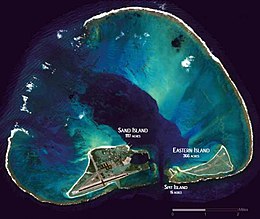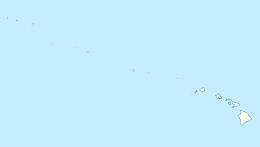Nickname: Midway Islands | |
|---|---|
 Satellite image of Midway Atoll | |
Midway Atoll northwest of Hawaii | |
| Geography | |
| Location | North Pacific Ocean |
| Coordinates | 28°12′27″N 177°21′00″W / 28.20750°N 177.35000°W |
| Archipelago | Hawaiian Archipelago |
| Total islands | 3 |
| Major islands | Sand, Eastern, Spit |
| Area | 1,549 acres (627 ha) |
| Length | 5 mi (8 km) |
| Width | 5 mi (8 km) |
| Highest elevation | 43 ft (13.1 m)[1] |
| Administration | |
| Department | Department of the Interior |
| Insular area | Midway Atoll |
| Operating unit | United States Fish and Wildlife Service |
| Largest Settlement | Sand Island (pop. 40[2]) |
| Demographics | |
| Demonym | Midway Islander |
| Population | 40 (2019 (est.)) |
| Pop. density | 16.5/sq mi (6.37/km2) |
| Additional information | |
| Time zone | |

Midway Atoll (colloquial: Midway Islands; Hawaiian: Kuaihelani, lit. 'the backbone of heaven'; Pihemanu, 'the loud din of birds')[3][4] is a 2.4 sq mi (6.2 km2) atoll in the North Pacific Ocean. Midway Atoll is an insular area of the United States and is an unorganized and unincorporated territory. The largest island is Sand Island, which has housing and an airstrip. Immediately east of Sand Island, across the narrow Brooks Channel, is Eastern Island, which is uninhabited and no longer has any facilities. Forming a rough, incomplete circle around the two main islands and creating Midway Lagoon is Spit Island, a narrow reef.[1]
Roughly equidistant between North America and Asia, Midway is the only island in the Hawaiian Archipelago that is not part of the state of Hawaii.[1] Unlike the other Hawaiian islands, Midway observes Samoa Time (UTC−11:00, i.e., eleven hours behind Coordinated Universal Time), which is one hour behind the time in the Hawaii–Aleutian Time Zone used in Hawaii. For statistical purposes, Midway is grouped as one of the United States Minor Outlying Islands. The Midway Atoll National Wildlife Refuge, encompassing 590,991.50 acres (239,165.77 ha)[5] of land and water in the surrounding area, is administered by the United States Fish and Wildlife Service (FWS). The refuge and surrounding area are part of the larger Papahānaumokuākea Marine National Monument.
From 1941 until 1993, the atoll was the home of Naval Air Facility Midway Island, which played a crucial role in the Battle of Midway, June 4–6, 1942. Aircraft based at the then-named Henderson Field on Eastern Island joined with United States Navy ships and planes in an attack on a Japanese battle group that sank four carriers and one heavy cruiser and defended the atoll from invasion. The battle was a critical Allied victory and a significant turning point of the Pacific campaign of World War II.
About 50 people live on Sand Island: U.S. Fish and Wildlife Service staff and contract workers.[2] Visiting the atoll is possible only for business reasons, which includes permanent and temporary staff, contractors, and volunteers, as the tourism program has been suspended due to budget cutbacks. In 2012, the last year that the visitor program was in operation, 332 people made the trip to Midway.[6][7][8][9][10] Tours focused on the unique ecology of Midway and its military history. The economy is derived solely from governmental sources. Nearly all supplies must be brought to the island by ship or plane, although a hydroponic greenhouse and garden supply some fresh fruits and vegetables.
- ^ a b c "MODIS Web: Home >> Images >> Midway Islands". modis.gsfc.nasa.gov. Archived from the original on June 4, 2022. Retrieved April 21, 2021.
- ^ a b "United States Pacific Island Wildlife Refuges". The World Factbook. CIA. September 27, 2023. Archived from the original on April 8, 2022. Retrieved September 29, 2023.
- ^ "Ua paʻa na inoa kahiko: Ancient Names Remembered" (PDF). Expand Papahānaumokuākea. Archived (PDF) from the original on August 27, 2021. Retrieved August 27, 2021.
- ^ "A visit to Pihemanu". BirdWatching. October 3, 2018. Archived from the original on July 20, 2021. Retrieved July 20, 2021.
- ^ System, National Wildlife Refuge. "Lands Report – National Wildlife Refuge System". fws.gov. Archived from the original on December 28, 2017. Retrieved September 16, 2016.
- ^ Visiting Midway Atoll National Wildlife Refuge. FWS Website.
- ^ Volunteer at Midway Atoll NWR. FWS Website.
- ^ Ecotourism ends at Midway Atoll [dead link]. Star-Advertiser, November 16, 2012
- ^ [1] Archived December 1, 2010, at the Wayback Machine. Galápagos Travel Website, November 16, 2012.
- ^ [2] Archived November 24, 2012, at the Wayback Machine. Photo Safaris Website, November 16, 2012.

